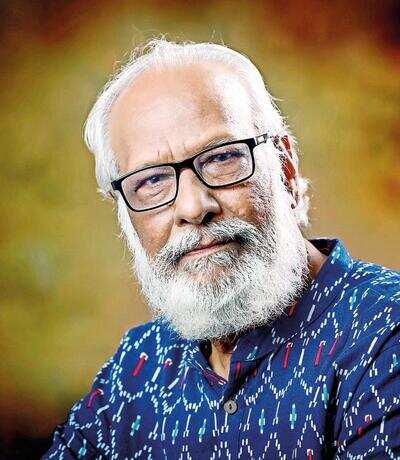- News
- City News
- nagpur News
- ‘Dream is to have activities for 365 days in Basoli’s golden jubilee year’
Trending Topics
‘Dream is to have activities for 365 days in Basoli’s golden jubilee year’

Fine art veteran Chandrakant Channe, who will soon celebrate his 75th birthday on June 1, is the creative force behind the renowned Basoli Group, which celebrated its 49th anniversary on May 14. Basoli Group has left an indelible mark on Nagpur, as it is known to almost every resident of the city. For nearly five decades, Channe and his Basoli Group have nurtured artistic talents of countless individuals, spanning across three generations in Nagpur. As Basoli Group reaches this significant milestone, Channe shared his insights with TOI, discussing the impact of art on children, the role of parents, and the future of the artistic community.
Excerpts from an interview...
Q. How does it feel to reach the milestone of 49 years of association with kids and the canvas?
A. It feels incredibly fulfilling. This journey has reinforced my belief that children are truly remarkable painters. Being a part of the Basoli family has given me a lifelong opportunity to not only be with them but also to be one of them. Throughout this journey, I have formed friendships with over 150,000 children. It is heartwarming to see that some of them have now grown into senior citizens and even grandparents, passing on the legacy by sending their grandchildren to Basoli. Some have pursued careers as artists, while others may have taken different paths. Nevertheless, we have nurtured a deep love for art in most of them.
Q. Did your upbringing at Shanti Niketan influence your decision to start Basoli?
A. Absolutely. The formative years spent at Shanti Niketan bestowed upon me a lifetime treasure of creativity. At Shanti Niketan, the fundamental principle is that learning cannot be confined within the four walls of a classroom. When I became a teacher in a conventional school, I yearned for the immersive learning experience I had enjoyed at Shanti Niketan. This longing led me to envision something similar, and thus Basoli came into existence. I consider myself fortunate to have had friends like Rajni Dandekar of Camlin who provided unwavering support and motivation. Rajni would generously supply colours free of cost, which I would distribute among the children at Basoli. This act attracted more children to join us. Unlike other art teachers in schools, Basoli Group enabled me to maintain a lasting connection with all my students, even after they moved on to higher classes or left school altogether. Drawing from my Shanti Niketan experience, I was able to nurture this relationship beyond the confines of mere professional or commercial gains.
Q. We’ve heard that you can identify the artist behind a drawing just by looking at it. Is this true?
A. That used to be true for a long time. I had a keen eye for recognizing the artist simply by observing their painting style. I could easily distinguish whether the artist was a girl or a boy, and even determine their age group based on their strokes and colour choices. However, in the past five to six years, I must admit that the younger generation, known as Generation Y, has proven me wrong. Girls have become more assertive, and their artistic style, strokes, and colour palettes are becoming increasingly like those of boys. The differences in their mindsets are fading away, which is a positive development. Let children have the freedom to explore and express themselves through colours, allowing them to understand the world around them in their own unique ways.
Q. Over the years, what kind of changes have you observed in parents?
A. Today’s parents tend to be excessively concerned about their children’s well-being and success. They often involve themselves in every aspect of their child’s life and strive to constantly evaluate their achievements. I often urge parents to trust me with their children and give them the space to grow, but this has become increasingly challenging for today’s parents. They have turned parenting into a demanding and stressful job. In my opinion, what children truly need is not just material resources, but time and attention from their parents. It is important to spend quality time with them, allowing them to learn and explore in their own unique ways.
Q. What were the challenges that Basoli faced at the beginning and what type of challenges does it face now?
A. In the early days, the main challenge was raising resources. However, nowadays, financial constraints are no longer a problem. I have numerous students who have become so successful and resourceful that they readily donate thousands of rupees upon my request. As a commercial artist, I can also raise significant funds by selling one of my artworks if the need arises. Additionally, Basoli has established international associations, such as the one with UNESCO, which provide generous grants. However, the current challenge lies in manpower. It is unfortunate that we lack sufficient staff to effectively manage the residential camp of Basoli, which used to be a major attraction for children in Nagpur until recently. The scarcity of dedicated manpower raises concerns about who will take over the reins of Basoli after me.
Q. What does the future hold for Basoli and its activities?
A. Looking ahead, I can share our plans for the milestone year we are celebrating. Our theme for this year is ‘Basoli Blue.’ I intend to encourage children to paint canvases in various shades of blue, drawing inspiration from literary works such as Sant Dnyaneshwar’s ‘Pasayadana,’ Tagore’s ‘Geetanjali,’ and the legendary poem ‘Ne Majasi Ne’ by Savarkar. The idea is to help children understand the essence of these poetic works and collaborate on painting large canvases together, using different shades of blue. Our project aligns with this year’s UNESCO theme, which is “From ME to WE.” Looking further into the future, our next milestone will be the golden jubilee, which will be next year. My dream is to plan activities for each of the 365 days of that special year. As I approach the age of 75, I am aware that my physical fitness may limit my ability to actively participate in these activities for many more years. However, I remain committed to nurturing Basoli and its endeavours as long as I am able.
Excerpts from an interview...
Q. How does it feel to reach the milestone of 49 years of association with kids and the canvas?
A. It feels incredibly fulfilling. This journey has reinforced my belief that children are truly remarkable painters. Being a part of the Basoli family has given me a lifelong opportunity to not only be with them but also to be one of them. Throughout this journey, I have formed friendships with over 150,000 children. It is heartwarming to see that some of them have now grown into senior citizens and even grandparents, passing on the legacy by sending their grandchildren to Basoli. Some have pursued careers as artists, while others may have taken different paths. Nevertheless, we have nurtured a deep love for art in most of them.
Q. Did your upbringing at Shanti Niketan influence your decision to start Basoli?
A. Absolutely. The formative years spent at Shanti Niketan bestowed upon me a lifetime treasure of creativity. At Shanti Niketan, the fundamental principle is that learning cannot be confined within the four walls of a classroom. When I became a teacher in a conventional school, I yearned for the immersive learning experience I had enjoyed at Shanti Niketan. This longing led me to envision something similar, and thus Basoli came into existence. I consider myself fortunate to have had friends like Rajni Dandekar of Camlin who provided unwavering support and motivation. Rajni would generously supply colours free of cost, which I would distribute among the children at Basoli. This act attracted more children to join us. Unlike other art teachers in schools, Basoli Group enabled me to maintain a lasting connection with all my students, even after they moved on to higher classes or left school altogether. Drawing from my Shanti Niketan experience, I was able to nurture this relationship beyond the confines of mere professional or commercial gains.
Q. We’ve heard that you can identify the artist behind a drawing just by looking at it. Is this true?
A. That used to be true for a long time. I had a keen eye for recognizing the artist simply by observing their painting style. I could easily distinguish whether the artist was a girl or a boy, and even determine their age group based on their strokes and colour choices. However, in the past five to six years, I must admit that the younger generation, known as Generation Y, has proven me wrong. Girls have become more assertive, and their artistic style, strokes, and colour palettes are becoming increasingly like those of boys. The differences in their mindsets are fading away, which is a positive development. Let children have the freedom to explore and express themselves through colours, allowing them to understand the world around them in their own unique ways.
Q. Over the years, what kind of changes have you observed in parents?
A. Today’s parents tend to be excessively concerned about their children’s well-being and success. They often involve themselves in every aspect of their child’s life and strive to constantly evaluate their achievements. I often urge parents to trust me with their children and give them the space to grow, but this has become increasingly challenging for today’s parents. They have turned parenting into a demanding and stressful job. In my opinion, what children truly need is not just material resources, but time and attention from their parents. It is important to spend quality time with them, allowing them to learn and explore in their own unique ways.
Q. What were the challenges that Basoli faced at the beginning and what type of challenges does it face now?
A. In the early days, the main challenge was raising resources. However, nowadays, financial constraints are no longer a problem. I have numerous students who have become so successful and resourceful that they readily donate thousands of rupees upon my request. As a commercial artist, I can also raise significant funds by selling one of my artworks if the need arises. Additionally, Basoli has established international associations, such as the one with UNESCO, which provide generous grants. However, the current challenge lies in manpower. It is unfortunate that we lack sufficient staff to effectively manage the residential camp of Basoli, which used to be a major attraction for children in Nagpur until recently. The scarcity of dedicated manpower raises concerns about who will take over the reins of Basoli after me.
Q. What does the future hold for Basoli and its activities?
A. Looking ahead, I can share our plans for the milestone year we are celebrating. Our theme for this year is ‘Basoli Blue.’ I intend to encourage children to paint canvases in various shades of blue, drawing inspiration from literary works such as Sant Dnyaneshwar’s ‘Pasayadana,’ Tagore’s ‘Geetanjali,’ and the legendary poem ‘Ne Majasi Ne’ by Savarkar. The idea is to help children understand the essence of these poetic works and collaborate on painting large canvases together, using different shades of blue. Our project aligns with this year’s UNESCO theme, which is “From ME to WE.” Looking further into the future, our next milestone will be the golden jubilee, which will be next year. My dream is to plan activities for each of the 365 days of that special year. As I approach the age of 75, I am aware that my physical fitness may limit my ability to actively participate in these activities for many more years. However, I remain committed to nurturing Basoli and its endeavours as long as I am able.

About the Author
Chaitanya DeshpandeChaitanya Deshpande is Principal Correspondent at The Times of India, Nagpur. He has a PG degree in English literature and Mass communication. Chaitanya covers public health, medical issues, medical education, research in the fields of medicine, microbiology, biotechnology. He also covers culture, fine arts, theatre, folk arts, literature, and life. Proficient in Marathi and Hindi along with English, Chaitanya loves music, theatre and literature of all three languages.
Start a Conversation
FOLLOW US ON SOCIAL MEDIA
FacebookTwitterInstagramKOO APPYOUTUBE







